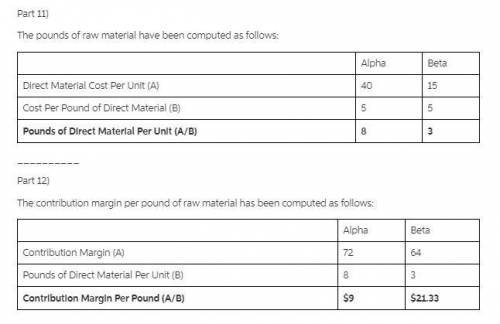
Business, 06.05.2020 00:57 emanihackle9
Cane Company manufactures two products called Alpha and Beta that sell for $195 and $150, respectively. Each product uses only one type of raw material that costs $5 per pound. The company has the capacity to annually produce 123,000 units of each product. Its unit costs for each product at this level of activity are given below:
Alpha Beta
Direct materials $40 $15
Direct labor 34 28
Variable manufacturing overhead 22 20
Traceable fixed manufacturing overhead 30 33
Variable selling expenses 27 23
Common fixed expenses 30 25
Total cost per unit $183 $144
The company considers its traceable fixed manufacturing overhead to be avoidable, whereas its common fixed expenses are deemed unavoidable and have been allocated to products based on sales dollars.
a. Assume that Cane normally produces and sells 75,000 Betas and 95,000 Alphas per year. If Cane discontinues the Beta product line, its sales representatives could increase sales of Alpha by 15,000 units. If Cane discontinues the Beta product line, how much would profits increase or decrease?
b. Assume that Cane expects to produce and sell 95,000 Alphas during the current year. A supplier has offered to manufacture and deliver 95,000 Alphas to Cane for a price of $140 per unit. If Cane buys 95,000 units from the supplier instead of making those units, how much will profits increase or decrease?
c. Assume that Cane expects to produce and sell 70,000 Alphas during the current year. A supplier has offered to manufacture and deliver 70,000 Alphas to Cane for a price of $140 per unit. If Cane buys 70,000 units from the supplier instead of making those units, how much will profits increase or decrease?
d. How many pounds of raw material are needed to make one unit of Alpha and one unit of Beta?
e. What contribution margin per pound of raw material is earned by Alpha and Beta?
f. Assume that Cane's customers would buy a maximum of 95,000 units of Alpha and 75,000 units of Beta. Also assume that the company's raw material available for production is limited to 245,000 pounds. How many units of each product should Cane produce to maximize its profits?
g. Assume that Cane's customers would buy a maximum of 95,000 units of Alpha and 75,000 units of Beta. Also assume that the company's raw material available for production is limited to 245,000 pounds. What is the maximum contribution margin Cane Company can earn given the limited quantity of raw materials?
h. Assume that Cane's customers would buy a maximum of 95,000 units of Alpha and 75,000 units of Beta. Also assume that the company's raw material available for production is limited to 245,000 pounds. Up to how much should it be willing to pay per pound for additional raw materials?

Answers: 3


Another question on Business

Business, 22.06.2019 05:20
Carmen co. can further process product j to produce product d. product j is currently selling for $20 per pound and costs $15.75 per pound to produce. product d would sell for $38 per pound and would require an additional cost of $8.55 per pound to produce. what is the differential revenue of producing product d?
Answers: 2

Business, 22.06.2019 12:00
Describe the three different ways the argument section of a cover letter can be formatted
Answers: 1

Business, 22.06.2019 13:00
Reliability and validity reliability and validity are two important considerations that must be made with any type of data collection. reliability refers to the ability to consistently produce a given result. in the context of psychological research, this would mean that any instruments or tools used to collect data do so in consistent, reproducible ways. unfortunately, being consistent in measurement does not necessarily mean that you have measured something correctly. to illustrate this concept, consider a kitchen scale that would be used to measure the weight of cereal that you eat in the morning. if the scale is not properly calibrated, it may consistently under- or overestimate the amount of cereal that’s being measured. while the scale is highly reliable in producing consistent results (e.g., the same amount of cereal poured onto the scale produces the same reading each time), those results are incorrect. this is where validity comes into play. validity refers to the extent to which a given instrument or tool accurately measures what it’s supposed to measure. while any valid measure is by necessity reliable, the reverse is not necessarily true. researchers strive to use instruments that are both highly reliable and valid.
Answers: 1

Business, 22.06.2019 19:40
An increase in the market price of men's haircuts, from $16 per haircut to $26 per haircut, initially causes a local barbershop to have its employees work overtime to increase the number of daily haircuts provided from 20 to 25. when the $26 market price remains unchanged for several weeks and all other things remain equal as well, the barbershop hires additional employees and provides 40 haircuts per day. what is the short-run price elasticity of supply? nothing (your answer should have two decimal places.) what is the long-run price elasticity of supply? nothing (your answer should have two decimal places.)
Answers: 1
You know the right answer?
Cane Company manufactures two products called Alpha and Beta that sell for $195 and $150, respective...
Questions

Mathematics, 30.07.2019 02:30




Biology, 30.07.2019 02:30












Biology, 30.07.2019 02:30



Social Studies, 30.07.2019 02:30





